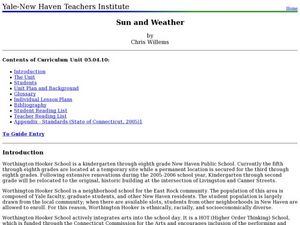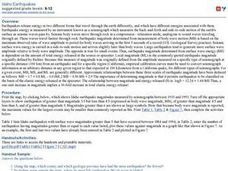Curated OER
Earthquakes- An Introduction
Sixth graders investigate the concepts related to creating an understanding of how earthquakes occur. They participate in a variety of activities that are tied to each other and focus upon the principle of plate tectonics. Then students...
Curated OER
Investigating the Types of Energy in Different Objects
Students investigate forms of energy. In this physical science energy lesson, students work with a partner classifying household items according to the type of energy they have. Students complete a related worksheet.
Curated OER
Cartoons for the Classroom: Safety vs. Energy
In this current events worksheet, learners analyze a political cartoon about energy sources and respond to 3 talking point questions.
Teach Engineering
Earthquakes Living Lab: The Theory of Plate Tectonics
Find out if your class agrees with Ice Age: Continental Drift ... or if it's just a fun family movie! Class members research the theory of continental drift, examine evidence of plate tectonics, connect this information to engineering,...
Curated OER
Stressed Out!
Have your class engage in lessons on earthquakes. Learners explore the science behind earthquakes using interactive websites and video clips. Then, they review the layers and parts of the Earth before delving into the causes of...
Curated OER
Sun and Weather
How is the Earth's weather created? Middle schoolers will explain how the Sun's energy is transformed into different forms. They will perform mathematical calculations of volume, mass, and temperature. They they will explain the...
Curated OER
Isoseismal Maps
Students examine the difference between magnitude and intensity in earthquakes. They complete map work and write a first hand account of a person living in each level of intensity on the Modified Mercalli Scale.
Carnegie Mellon University
How Power Plants Work 1
First of three lessons, this is a great start to a unit on energy. As you demonstrate, learners discover different types of energy and how it is converted from one form to another. They then focus in on the generation of electricity by...
Curated OER
Nuclear Energy - Is it a Friend or Foe?
You can provide your students with content knowledge and hone critical thinking skills with these timely lesson plans on nuclear energy.
Curated OER
Bigger Faults Make Bigger Earthquakes
Students experiment with string to visualize how earthquakes are created. Using various lengths of string, students determine which earthquakes lasted the longest and hypothesize why. Students look at a fault map and determine which may...
Science Matters
Wave Watching
Seismologists use the direction and arrival times of p waves and s waves to determine the distance to the source of an earthquake. The engaging lesson has students line up to form human waves. Through different movements when attached,...
Science Matters
Richter Scale
The 12th instructional activity in a series of 20 opens with a demonstration of exponential functions using pasta. This concept is connected to the Richter Scale, which is also an exponential function. Scholars compare the exponential...
Science Matters
Slip Sliding Along
The San Andreas Fault is the largest earthquake-producing fault in California. In the seventh lesson in the 20 part series, pupils create maps of California, focusing on the San Andreas Fault system. The comparison of where California is...
Curated OER
Idaho Earthquakes
High schoolers examine the types of earthquakes that occur in Idaho. In groups, they compare and contrast the types of energy released and how they affect the movement of the Earth. To end the instructional activity, they analyze a map...
Curated OER
Earthquake, Earthquake, Read All About It!
Pupils utilize the U.S. Geological Service web site. They research the various types of scales used to measure earthquakes and classify different situations on the scale. They write a story about a town that has just experienced a quake.
Curated OER
Magnitude of Earthquakes
Students investigate the causes and effects of earthquakes and investigate their magnitude. For this earthquakes lesson, students study the Richter Scale and measure it as it relates to the energy released by an earthquake. Students...
Curated OER
Earthquake Information
In this earthquake learning exercise, students complete a crossword puzzle by determining the terms associated with the 8 given clues.
Curated OER
Student Exploration: Energy Conversions
In this earthquake exploration instructional activity, students complete 3 prior knowledge questions, then use "Energy Conversions Gizmo" to conduct several activities, completing short answer questions when finished.
Curated OER
Stick-Slip Movement
Ninth graders operate a model to observe the type of motion that occurs at a fault during an earthquake. They explore the effects of several variables. Students measure movement, calculate averages and plot and graph information.
Curated OER
A Whole Lot of Shakin' Goin' On!
Students review characteristics of an earthquake. They explore information about earthquakes to determine the effects of an earthquake. They compare the earthquakes of 1906 and 1989.
Curated OER
Seismic Waves
In this seismic waves activity, student will read information about the different types of waves that occur during an earthquake: P (Primary) waves, S (Secondary) waves, and shear waves. Then students will complete 2 short answer questions.
Curated OER
Shake, Rattle and Roll
Sixth graders explore the causes and effects of earthquakes. They also collect and analyze data in graphs. They also use the Internet to research earthquakes
Curated OER
What's Shaking?
In this Earth movements worksheet, students compare and contrast earthquakes and volcanoes. Students write a short essay about the similarities and differences and then complete 4 matching questions.
Curated OER
Tsunami
Students explore tsunami through various hands-on activities. In this earth science lesson, students explain how they are formed. They create tsunami and earthquake models in the lab to observe how they are generated.

























